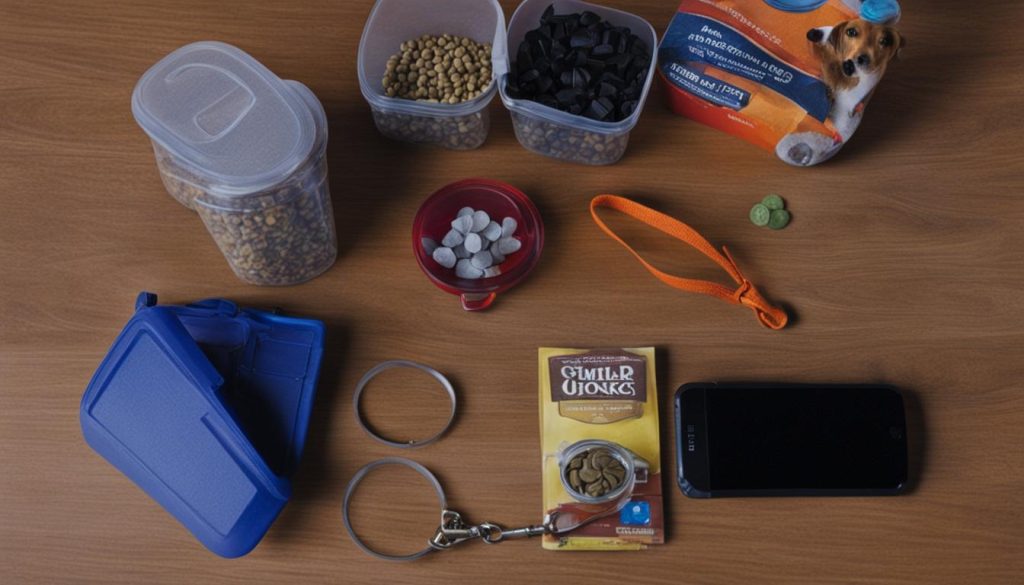Teaching your dog to sit is a fundamental command in dog training. It has practical applications such as ensuring safety when crossing roads and preventing jumping when greeting people. To teach your dog to sit, start with a tasty treat and hold it near their nose. Move your hand in an arc over their head, causing them to follow the treat and sit down. Praise them and give them the treat as a reward. Practice this in short, regular sessions, gradually adding the cue word “sit” before your dog moves into position.
Key Takeaways:
- Teaching your dog to sit is an important command for their safety and behavior.
- Start by using a treat to lure your dog into a sitting position.
- Offer praise and rewards as positive reinforcement.
- Continue practicing short sessions to reinforce the behavior.
- Gradually add the cue word “sit” to associate the action.
Steps to Teach Your Dog to Sit

Teaching your dog to sit is an important skill that forms the foundation for other commands and behaviors. Follow these steps to effectively teach your dog the sit command:
- Choose a quiet and distraction-free environment for training.
- Hold a treat in your hand and let your dog smell it.
- Raise the treat slowly above your dog’s head, causing them to naturally lower their hind end into a sitting position.
- As soon as your dog is sitting, say “good sit” or use another verbal cue to mark the behavior.
- Immediately give your dog the treat as a reward to reinforce the action.
- Repeat this process for several short training sessions throughout the day.
- Gradually phase out the treat by still using the hand motion but not giving the treat every time.
- Once your dog consistently responds to the hand motion, introduce a verbal cue such as “sit.”
- Practice in different locations and gradually increase distractions to ensure your dog understands the command in various situations.
Consistency and positive reinforcement are key to successful training. Remember to be patient and reward your dog for their efforts. With practice, your dog will learn to sit on command and become a well-behaved companion.
Make Sitting a Default Behavior

A helpful strategy in teaching your dog to sit is to make it a default behavior. This means that your dog chooses to sit in the absence of a cue from you. To achieve this, reinforce your dog for sitting whenever they choose to do it on their own. Reward them with treats, playtime, or other forms of positive reinforcement. By consistently reinforcing this behavior, your dog will start offering sits in various situations, making it a natural response to different stimuli.
For example, if your dog sits on their own before you put their leash on, reward them with praise and a treat. If they sit politely when waiting for their meal, praise them and give them their food. By rewarding these spontaneous sits, you are encouraging your dog to make it a default behavior.
Consistency is key when using this technique. Make sure to reward your dog every time they choose to sit without being prompted. Over time, they will associate sitting with positive reinforcement and will be more likely to do it on their own.
| Benefits of Making Sitting a Default Behavior: |
|---|
| Improved impulse control |
| Enhanced focus and attention |
| Decreased jumping and excessive excitement |
| Safer interactions with strangers and other dogs |
| Increased overall obedience and responsiveness |
By making sitting a default behavior, you are setting your dog up for success in various situations. It also helps in preventing unwanted behaviors such as jumping, lunging, or excessive barking. With consistent reinforcement and positive training techniques, your dog will learn to sit on their own and become a well-behaved companion.
Next, we will explore how to teach your dog the trick of sitting pretty, which is a fun and impressive variation of the basic sit command.
Teach Your Dog to Sit Pretty

Once your dog has mastered the basic sit command, you can take their training to the next level by teaching them to sit pretty. This adorable trick involves your dog sitting on their haunches with their front paws in the air, almost like they’re begging. Not only is it a cute party trick, but it also helps strengthen your dog’s core muscles.
To teach your dog to sit pretty, start by asking them to sit in a standard sitting position. Hold a tasty treat in front of their nose and slowly lift it upward. As their front paws start to come off the ground, click your clicker or use a verbal marker and give them the treat as a reward. Repeat this process, gradually raising the treat higher each time, until your dog is sitting pretty with their front paws fully extended.
As you progress with the training, you can begin to fade out the lure by using an empty hand as the signal. Simply hold your hand in the same position as when you were holding the treat, and your dog will understand the desired behavior. You can also add a verbal cue, such as “sit pretty” or “beg,” to further reinforce the command.
“Teaching your dog to sit pretty not only adds a fun and adorable element to their training repertoire, but it also helps build their core strength.”
| Benefits of Teaching Your Dog to Sit Pretty | Steps to Teach Your Dog to Sit Pretty |
|---|---|
|
|
Teaching your dog to sit pretty not only adds a fun and adorable element to their training repertoire, but it also helps build their core strength. By following the steps outlined above and being consistent with your training sessions, you can successfully teach your dog this impressive trick. Remember to always use positive reinforcement, such as treats and praise, to reward your dog for their efforts.
Supplies You’ll Need for Teaching a Dog to Sit

When it comes to teaching your dog to sit, having the right supplies can make the training process smoother and more effective. Here are the essential items you’ll need:
Treats:
High-quality training treats are crucial for motivating your dog and reinforcing the desired behavior. Look for treats that are specifically designed for training, such as True Chews Premium Jerky Cuts with Real Chicken Dog Treats. These tasty treats will keep your dog engaged and eager to learn.
Quiet Training Space:
A calm and quiet environment is essential for successful training sessions. Choose a space where your dog can focus without distractions. This could be a designated area in your home or a quiet corner of your backyard.
Dedicated Training Time:
Consistency is key when it comes to training your dog to sit. Set aside 15 to 20 minutes each day for dedicated training sessions. Regular practice will help your dog understand and retain the command.
By ensuring you have these essential supplies, you’ll be well-prepared to teach your dog to sit and set them up for success in their training journey.
Step-by-Step Instructions for Teaching a Dog to Sit

If you’re ready to teach your dog to sit, follow these simple step-by-step instructions. Remember to be patient and consistent throughout the training process.
Step 1: Start by holding a tasty treat in your hand to get your dog’s attention. Make sure you are in a calm and comfortable training area.
Step 2: Slowly move the treat above your dog’s head and slightly behind them. The goal is to encourage them to follow the treat and move into a sitting position. As they lower their rear end to the ground, praise them and immediately give them the treat as a reward.
Step 3: Repeat this process for about 10 to 15 repetitions during each training session. Count your dog training treats beforehand to keep track of the repetitions. Consistency is key in reinforcing the desired behavior.
Step 4: Gradually introduce the verbal cue “sit” as your dog starts to associate the action with the command. Say “sit” just before you move the treat to guide them into the sitting position. Over time, they will learn to respond to the verbal cue alone.
Things to Avoid when Teaching a Dog to Sit
When it comes to teaching your dog to sit, there are a few things that you should avoid in order to ensure successful training sessions. These tips will help you create a positive and effective learning experience for your furry friend.
Avoid Pushing Down Your Dog’s Hind End
One common mistake that some dog owners make is trying to push down their dog’s hind end to make them sit. This can be intimidating and confusing for your dog, and it may even cause them to resist the training altogether. Instead, focus on using positive reinforcement and reward-based methods to encourage your dog to sit on their own.
Present the Treat While Your Dog is Sitting
Another important thing to avoid is waiting until your dog is standing again to give them the treat. When teaching your dog to sit, always present the treat while they are in the sitting position. This will help reinforce the connection between the command and the desired behavior, and it will also prevent your dog from popping out of the sit as soon as they receive the treat.
Avoid Forcing Your Dog into the Sit Position
Lastly, it’s important to avoid forcing your dog into the sit position, especially in stressful situations. Forcing your dog can create anxiety and resistance, making it more difficult for them to learn and respond to your commands. Instead, use positive reinforcement, patience, and consistency to encourage your dog to sit willingly.
By following these tips and avoiding these common mistakes, you can set your dog up for success in learning the sit command. Remember to be patient, consistent, and always use positive reinforcement to create a positive training experience for your furry friend.
Wrapping Up

Teaching your dog to sit is an essential part of basic dog training. It lays the foundation for further training and helps control your dog’s impulses. By following step-by-step instructions, using positive reinforcement, and avoiding common mistakes, you can successfully teach your dog to sit. Remember to make the training sessions fun and rewarding for both you and your furry friend.
Throughout the training process, it’s important to be patient and consistent. Practice short, regular sessions to reinforce the sit command and gradually add the cue word “sit” before your dog moves into position. Remember to use treats as rewards and praise your dog for their efforts.
Once your dog has mastered the basic sit command, you can even teach them fun tricks like sitting pretty. This adorable trick involves sitting on their haunches with their front paws in the air. With practice and positive reinforcement, your dog can learn to perform this trick on command.
By investing time and effort into teaching your dog to sit, you’re not only improving their obedience but also strengthening the bond between you and your furry companion. Remember, consistency, patience, and positive reinforcement are key to successful dog training. Happy teaching!
Related Articles
Looking for more information on dog training? Check out these related articles that provide valuable insights and tips:
- 10 Essential Dog Training Tips
- Mastering Leash Training: A Guide for Dog Owners
- Solutions for Problem Barking: Training Your Dog to Be Quiet
- Crate Training Basics: How to Make Your Dog Feel at Home
- Potty Training Dogs: A Step-by-Step Guide for Success
These articles cover a range of topics related to dog training and provide additional resources to help you enhance your training techniques and strengthen the bond with your furry companion.
Remember, dog training is an ongoing process, and seeking knowledge from various sources can help you gain different perspectives and strategies to achieve your training goals.
Additional FAQs
Here are some frequently asked questions about teaching a dog to sit:
Q: How long does it take to teach a dog to sit?
A: The time it takes to teach a dog to sit can vary depending on the dog’s breed, age, and individual temperament. However, with consistent training and positive reinforcement, most dogs can learn to sit within a few weeks.
Q: Can I use any type of treat to reward my dog?
A: While treats are a common form of positive reinforcement, it’s important to choose treats that are safe and healthy for your dog. Look for treats specifically designed for dogs, avoiding ingredients that may be harmful or cause allergies. Consult with your veterinarian for recommendations.
Q: What if my dog doesn’t respond to the sit command?
A: If your dog doesn’t respond to the sit command, it may be helpful to revisit the training technique. Ensure that you are using a clear and consistent cue, such as saying “sit” in a firm yet gentle tone. You can also try using a different reward or adjusting the training environment to minimize distractions.
Remember, every dog learns at their own pace, so be patient and persistent in your training efforts.
FAQ
Can I teach my dog to sit using treats?
Yes, using treats as a reward can be an effective way to teach your dog to sit. Start by holding a treat near their nose and gradually move it over their head, causing them to follow the treat and sit down. Praise them and give them the treat as a reward. Repeat this process in short, regular sessions.
How long does it take to teach a dog to sit?
The time it takes to teach a dog to sit can vary depending on the individual dog and their learning capabilities. With consistent practice and positive reinforcement, many dogs can learn to sit within a few weeks.
What should I do if my dog doesn’t sit when I give the command?
If your dog doesn’t sit when you give the command, go back to the basics and reinforce the training steps. Make sure you are using a clear and consistent cue word, such as “sit,” and that you are rewarding your dog for the correct behavior. Be patient and continue practicing until your dog understands the command.
Can I teach an older dog to sit?
Yes, you can teach an older dog to sit. The training steps are the same, but it may require more patience and repetition. Older dogs can still learn new commands and behaviors with consistent training and positive reinforcement.
Is it important to use a clicker when teaching a dog to sit?
Using a clicker can be helpful in training your dog to sit, but it is not necessary. Clickers provide a distinct sound that marks the desired behavior and can aid in communication with your dog. However, you can also use verbal praise, treats, and positive reinforcement to teach your dog to sit without a clicker.






